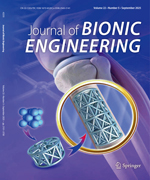|
|
A Review of Research on the Mechanical Design of Hoverable Flapping Wing Micro‑Air Vehicles
Shengjie Xiao, Kai Hu, Binxiao Huang, Huichao Deng, Xilun Ding
Journal of Bionic Engineering. 2021, 18 (6):
1235-1254.
DOI: 10.1007/s42235-021-00118-4
Recently, researchers have concentrated on studying ionic polymer metal composite (IPMC) artifcial muscle, which has
numerous advantages including a relatively large strain under low input voltage, fexibility, high response, low noise, light
weight, and high driving energy density. This paper reports recent developments in IPMC artifcial muscle, including
improvement methods, modeling, and applications. Diferent types of IPMCs are described, along with various methods for
overcoming some shortcomings, including improvement of Nafon matrix membranes, surface preparation of Nafon mem�branes, the choice of high-performing electrodes, and new electro-active polymers for enhancing the properties of IPMCs.
IPMC models are also reviewed, providing theoretical guidance for studying the performance and applications of IPMCs.
Successful applications such as bio-inspired robots, opto-mechatronic systems, and medical engineering are discussed.
Related Articles |
Metrics
|

 Table of Content
Table of Content
 Table of Content
Table of Content